CONCEALMENT, CAPACITY COLLIDE IN SPRINGFIELD ARMORY HELLCAT
9th Jun 2020
Source Credit to guns.com | by Jacki Billings
Introduced in fall 2019, the Hellcat caught the attention of the industry with its small stature but impressive capacity. Boasting 13+1 rounds with an extended mag and 11+1 with the flush fit mag, the Hellcat aimed to offer concealed carriers the ability to flawlessly conceal without sacrificing much in the way of capacity.
After a 100-round initial review, I took the Hellcat back to the range and out on the town to see how well it would stack up under more scrutiny.
THE BASICS
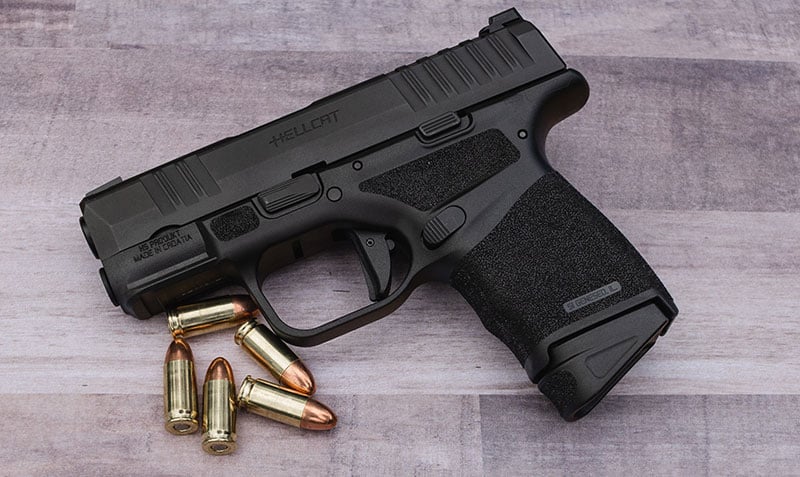
The Hellcat made waves in 2019 with its 13+1 capacity and small frame. (Photo: Jacki Billings/Guns.com)
Measuring 6-inches in total length, the Hellcat brings a 4-inch height, 1-inch width, and 3-inch barrel. The Hellcat weighs in around 18-ounces and comes in two models — a standard and Optics Ready, known as the OSP. For this review, I tested the standard model.
Aesthetically, the gun comes with top slide serrations which come in handy for racking. They are easy to grip and rip as you prep the gun for firing. The grip texture provides positive contact without completely shredding your hand while shooting. The frame also sports a reversible mag release button which makes it easier for the southpaws among us. Topping off some bells and whistles is a non-proprietary accessory rail for lights and lasers and a Tritium front sight and Tactical Rack U-Dot rear sights.
The sight set-up was fairly enjoyable while firing. The Tritium grabs your attention and makes it easy to place the sight on target. I’ve always preferred Tritium to standard white dot, so it’s nice that Springfield included that on the Hellcat.
CONCEALMENT
As most of my readers know, my EDC is usually a midsize pistol – either the Glock G19 or, most recently, the Shadow Systems MR918. There are times, though, when a gal has to step down to a subcompact. Usually, that means toting a Smith & Wesson Shield in either a Dark Star Gear holster or a Can Can Concealment Hip Hugger for non-belted carry. Stacked up against the Shield, the Hellcat is noticeably smaller and has the added benefit of more rounds.
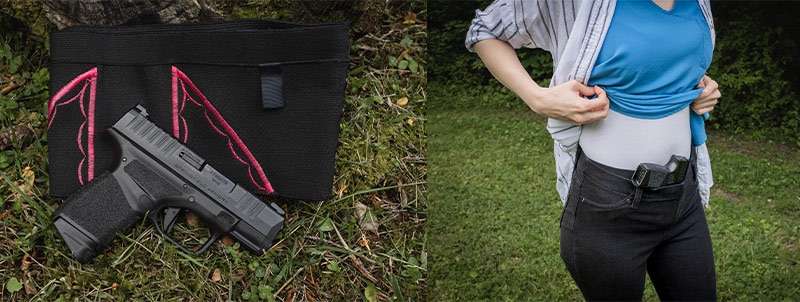
The author popped the Hellcat in a Can Can Concealment Hip Hugger holster. (Photo: Jacki Billings/Guns.com)
I popped the Hellcat in my Can Can Hip Hugger and it all but disappeared on my body. Though small, I was still able to easily access and draw the gun. I was really impressed with how little it printed and how well it rode in the holster. If you are someone who struggles to conceal, the Hellcat offers a solution with its slim build.
AT THE RANGE
In my first look at the Hellcat, I noted that the gun has some snap to it. That’s not shocking nor surprising as it features a compact size paired with that 9mm round. You’d be hard-pressed to find any subcompact that doesn’t come with a little recoil. That being said, it’s easy to control if you train to it and practice maintaining a good grip with good mechanics.
Over the course of testing, I sent hundreds of rounds downrange – everything from Hornady Critical Defense to Winchester white box and even some random cheap ammo I found while spring cleaning. The Hellcat performed admirably with no malfunctions or hiccups.
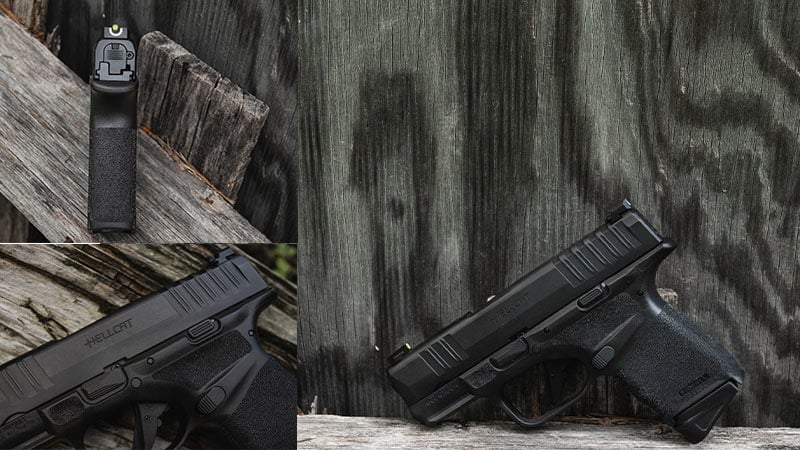
The sight set-up and grip texture proved useful at the range. (Photo: Jacki Billings/Guns.com)
When it comes to gripes, my biggest centers around the trigger. Though it boasts a flat-faced design, I didn’t enjoy the Hellcat’s trigger. The Hellcat has some grit to it, not a feature I am a fan of when it comes to triggers. I prefer a smoother trigger that I can cleanly press through. I notice when presented with triggers that have a grittier feel, I tend to slap the trigger more because I just don’t enjoy that press. The Hellcat was no exception.
While we are on the topic of the trigger, let’s talk about another issue that has cropped up for some who have tried their hand at the Hellcat. The Hellcat is equipped with a trigger safety meaning that there is a small lever ahead of the actual trigger that must be actuated to allow the trigger to be depressed and the gun to fire. This, of course, is there to prevent the trigger from snagging, on say clothes, and discharging.
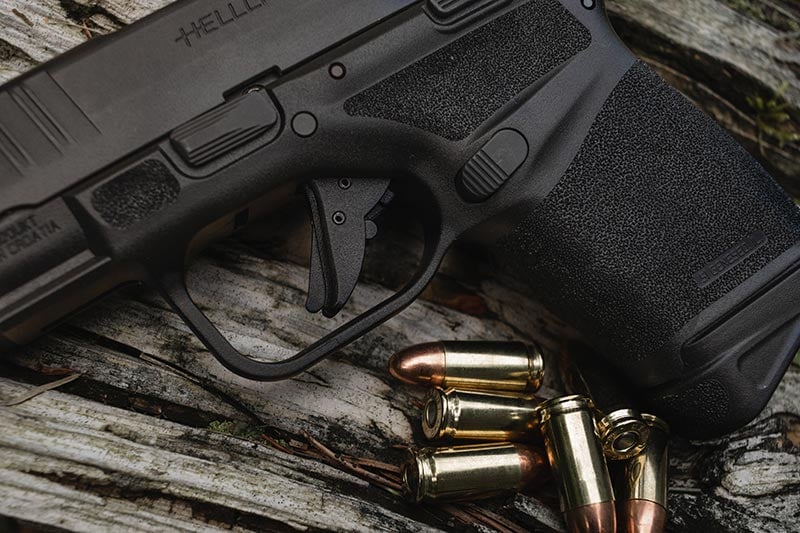
The trigger was gritty and the author noted that the trigger safety can be problematic in certain scenarios. (Photo: Jacki Billings/Guns.com)
If you have a sloppier grip resulting in bad trigger manipulation, this safety can be problematic. On the Hellcat, if you accidentally place sideways pressure on the trigger as you attempt to it pull it, the trigger locks up completely — meaning it won’t engage and the gun won’t fire. To remedy this, let off the trigger for a second and then re-apply direct, even pressure. For me, this rectified the situation and allowed the trigger to engage.
This is important to know if you are planning on carrying the Hellcat – make sure to practice your trigger pull ahead of popping this bad boy in a holster. I suggest some time dry firing and then practice at the range to reinforce good trigger manipulation, making sure to apply consistent and direct pressure. So long as you train and dry fire, as you should be doing anyway, you should be fine with the Hellcat.
FINAL THOUGHTS
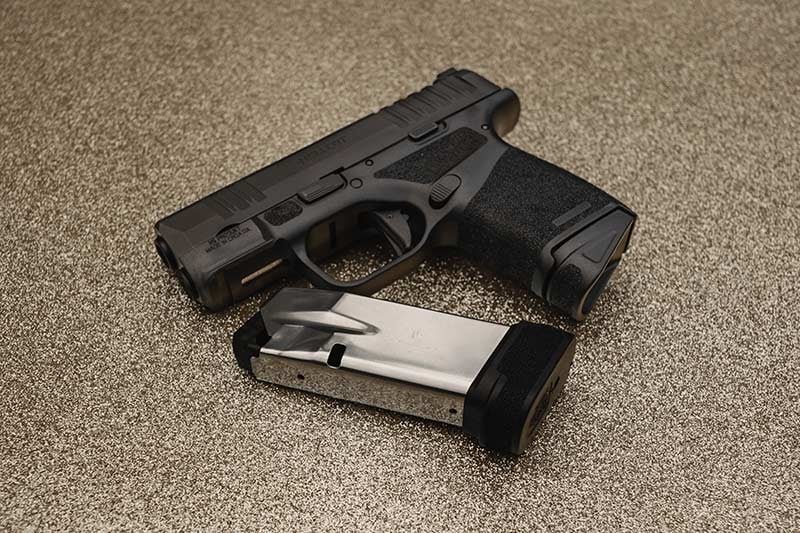
Overall, the Hellcat did well and its capacity is a definite improvement over sub-compacts of the past. (Photo: Jacki Billings/Guns.com)
After several hundred rounds down range and carrying for a couple of months — where do I stand on the Hellcat?
If you’re after a higher capacity gun that isn’t monstrous in size, the Hellcat definitely does the job. If you prefer comfort while shooting — be that reduced recoil or a smoother trigger — then I would pass this up in favor of one of its competitors. At the end of the day, the Hellcat worked reliably and concealed well.
The base model Hellcat retails for $569 while the OSP version comes in slightly more at $599.

